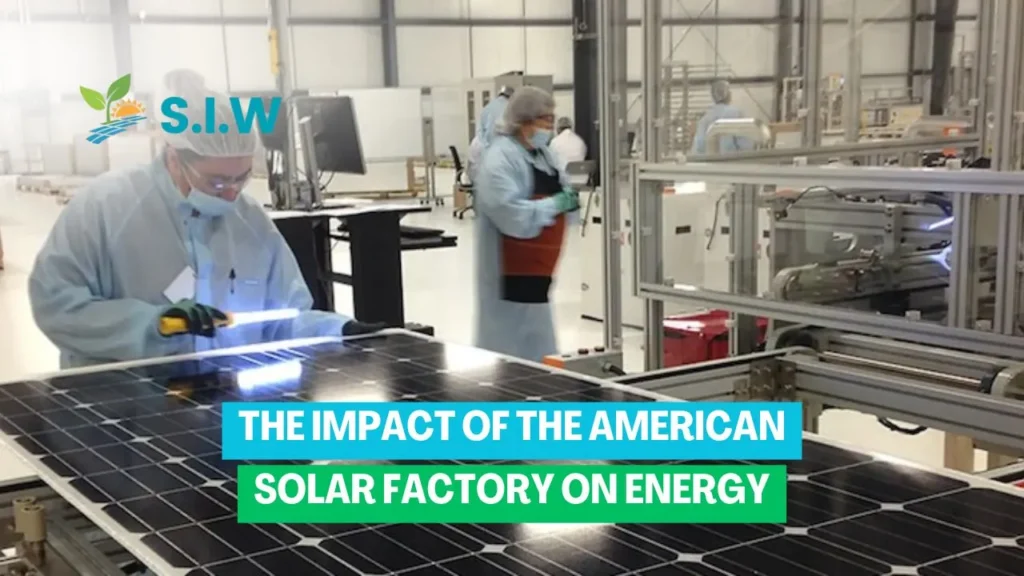American solar factories play a crucial role in the production and advancement of solar technology. These factories produce solar panels and equipment that convert sunlight into electricity. By focusing on sustainable manufacturing practices, they contribute significantly to reducing global carbon emissions. But they are more than just production lines—they are beacons of hope for a future powered by clean energy.
The Rise of Solar Power in America
Solar power has become a major player in America’s energy landscape. Over the past decade, solar installations have skyrocketed, driven by the need for cleaner, renewable energy sources. With growing concerns about climate change and the environment, more people are looking to solar power as a solution. It’s no surprise that American solar factories are expanding rapidly to meet the increasing demand for solar products.
What Goes on Inside a Solar Factory?
When you think of a solar factory, imagine a bustling facility where state-of-the-art machines and skilled workers come together to create powerful, high-tech solar panels. From the initial design phase to the final product, everything happens within these factories. Solar cells are meticulously assembled, tested for efficiency, and then packaged for shipment to homes and businesses across the country.
The Technology Behind Solar Panels
At the heart of solar panels is photovoltaic (PV) technology. This technology converts sunlight directly into electricity. In simple terms, solar panels capture photons from the sun, which then knock electrons loose, creating an electrical current. This process is known as the “photovoltaic effect.” The technology continues to evolve, making solar panels more efficient and cost-effective every year.
Economic Benefits of Solar Factories
Solar factories contribute significantly to the American economy by creating jobs and reducing energy costs. Thousands of jobs have been generated in manufacturing, engineering, and installation. Moreover, the energy produced by solar panels can drastically cut electricity bills for consumers, making renewable energy not just an environmentally friendly option, but also a financially smart one.
Environmental Impact of Solar Manufacturing
While solar energy is a clean source of power, the manufacturing process of solar panels does have an environmental footprint. However, compared to traditional energy sources like coal and oil, the impact is much smaller. Many American solar factories are adopting greener manufacturing processes, using recyclable materials, and minimizing waste to ensure their operations are as eco-friendly as possible.
Challenges Faced by American Solar Factories
Like any industry, solar manufacturing faces its challenges. One of the biggest hurdles is the high upfront cost of setting up solar factories. Additionally, there is competition from overseas manufacturers, especially those in countries with lower production costs. Despite these challenges, American solar factories continue to thrive, thanks to innovation and strong support from both the public and private sectors.
Government Support and Policies
Government policies and incentives have been critical in supporting the growth of solar energy in the U.S. Tax credits, subsidies, and grants help make solar projects more affordable for both manufacturers and consumers. The federal government, along with various state governments, has implemented programs that encourage investment in solar technology, ensuring the continued growth of the industry.
Future Trends in Solar Manufacturing
The future of solar manufacturing is bright, especially for commercial solar panels. As technology advances, we can expect to see more efficient solar panels and innovative energy storage solutions. Some American solar factories are already experimenting with new materials, such as perovskite, which could revolutionize the industry by making commercial solar panels even cheaper and more efficient. The integration of artificial intelligence (AI) and automation in manufacturing processes will also increase production rates and reduce costs, making solar energy more accessible for businesses and industries alike.
How You Can Support Solar Initiatives
You don’t have to be a solar expert to support the industry. Simply choosing to install solar panels at your home or business can make a significant difference. Additionally, advocating for policies that support renewable energy, investing in solar companies, or even just educating yourself and others about the benefits of solar power can help push the movement forward.
The Future is Solar
American solar factories are at the forefront of the clean energy movement. They are driving innovation, creating jobs, and helping to reduce our reliance on fossil fuels. With continued support from consumers, businesses, and governments, solar power will become an even more integral part of our energy future. The next time you see a solar panel, remember that it’s not just a piece of technology—it’s a symbol of progress toward a cleaner, more sustainable world.
Frequently Asked Questions
- How do American solar factories benefit the economy?
American solar factories create jobs, reduce energy costs, and contribute to economic growth by producing clean, affordable energy solutions. - What challenges do solar factories face in the U.S.?
The main challenges include high setup costs and competition from overseas manufacturers. However, strong government support helps mitigate these issues. - How can I support solar energy initiatives?
You can support solar initiatives by installing solar panels, advocating for renewable energy policies, or investing in solar companies. - Are solar panels from American factories more efficient?
American-made solar panels are known for their high quality and efficiency due to advanced manufacturing processes and rigorous testing standards. - What is the future of solar manufacturing in the U.S.?
The future looks promising, with innovations in materials, AI-driven manufacturing, and increased government support driving the industry forward.








